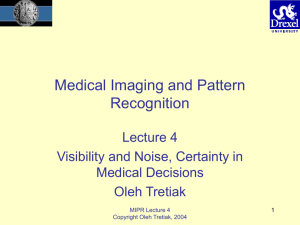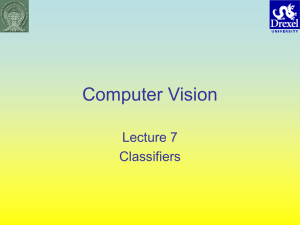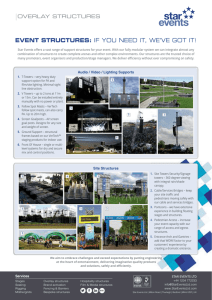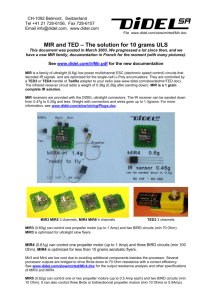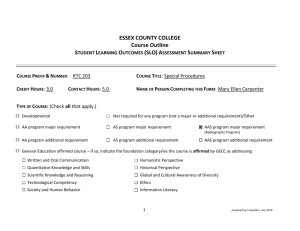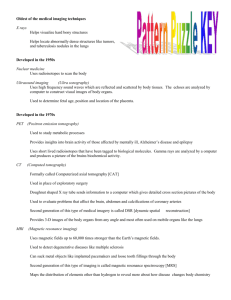01MIPRE
advertisement
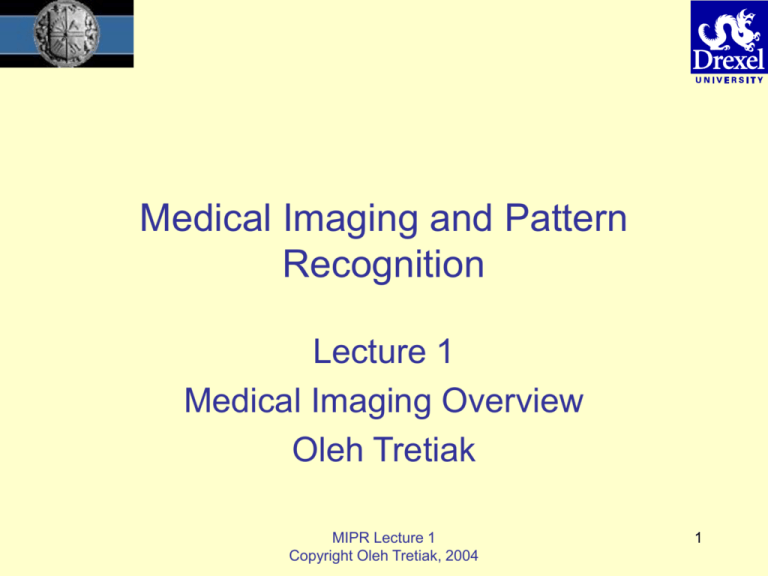
Medical Imaging and Pattern Recognition Lecture 1 Medical Imaging Overview Oleh Tretiak MIPR Lecture 1 Copyright Oleh Tretiak, 2004 1 Introduction The first part of the course will provide an introduction to medical imaging modalities, on object-image relationship and the relationship between the state of the object and image features. The second part of the course will cover statistical pattern recognition methods and methodologies for performance evaluation. MIPR Lecture 1 Copyright Oleh Tretiak, 2004 2 Course Outline • Part 1: Imaging models and methods – – – – – Introduction Linear system theory and Fourier analysis Probability and random processes Image acquisition and storage Image processing operations. Unary operations. Linear and nonlinear filtering. Morphological operations. Segmentation. – Laboratory 1. Introduction to ImageJ. Scanning. Characterization of an imaging device. – Laboratory 2. Image processing. Experiments with standard operations. Problem solving experiments. MIPR Lecture 1 Copyright Oleh Tretiak, 2004 3 Course Outline: More • Diagnostic Imaging Modalities – X-ray imaging: X-ray attenuation and scattering. Contrast mechanisms. Dose. Three-dimensional imaging. – Computer tomography: Radon transform and its inversion. X-ray, SPECT, and PET tomography. – Magnetic Resonance Imaging. Signal generation. Scanner operation and inversion. Pulse sequences. – Laboratory 3. Medical image processing. Experiments with CT image stacks and image subtraction. MIPR Lecture 1 Copyright Oleh Tretiak, 2004 4 Course Outline: Yet more • Part 2: Statistical Pattern Recognition – Foundations of statistical pattern recognition. Statistical estimation, hypothesis testing. – Estimation problems in patter recognition. Linear classifiers. – Neural nets and training rules. Backpropagation. – Evaluation methods: resubstitution, leave-one-out. ROC methods: parametric and ordinal dominance. Bootstrap and permutation. – Review and overview: topics in medical image research. – Lab 4. Methods of data plotting and analysis. Pseudorandom numbers and modeling. Bootstrap. – Lab 5. Classification with linear classifiers. Experiments on neural-net training. MIPR Lecture 1 Copyright Oleh Tretiak, 2004 5 Formal Details • Instructor: Oleh Tretiak – tretiak@coe.drexel.edu • Course web site: – http://www.ece.drexel.edu/faculty/tretiak/KPI/ MIPR Lecture 1 Copyright Oleh Tretiak, 2004 6 This Lecture’s Outline • Examples of medical images • The imaging triangle: object, image, observer • Imaging categories in medicine • Physics, biology, and imaging MIPR Lecture 1 Copyright Oleh Tretiak, 2004 7 Examples of Medical Images MIPR Lecture 1 Copyright Oleh Tretiak, 2004 8 Questions • What does the image show? • What good is it? • How is it made? MIPR Lecture 1 Copyright Oleh Tretiak, 2004 9 X-ray Image MIPR Lecture 1 Copyright Oleh Tretiak, 2004 10 X-ray Image of Hand MIPR Lecture 1 Copyright Oleh Tretiak, 2004 11 What is it? • Two X-ray views of the same hand are formed on an single film by exposing the hand onto half of the film while the other half is blocked by an opaque screen. MIPR Lecture 1 Copyright Oleh Tretiak, 2004 12 What good is it? • A fracture of the middle finger is seen on both views, though it is clearer on the view on the left. This image can be used for diagnosis - to distinguish between a sprain and a fracture, and to choose a course of treatment. MIPR Lecture 1 Copyright Oleh Tretiak, 2004 13 X-ray Imaging: How it works. X-ray shadow cast by an object Strength of shadow depends on composition and thickness. MIPR Lecture 1 Copyright Oleh Tretiak, 2004 14 Summary: X-ray Imaging • Oldest non-invasive imaging of internal structures • Rapid, short exposure time, inexpensive • Unable to distinguish between soft tissues in head, abdomen • Real time X-ray imaging is possible and used during interventional procedures. • Ionizing radiation: risk of cancer. MIPR Lecture 1 Copyright Oleh Tretiak, 2004 15 CT (Computed Tomography) CT Image of plane through liver and stomach Projection image from CT scans MIPR Lecture 1 Copyright Oleh Tretiak, 2004 16 What Is It? • Computer Tomography image of section through upper abdomen of patient prior to abdominal surgery. • Section shows ribs, vertebra, aorta, liver (image left), stomach (image right) partially filled with liquid (bottom). MIPR Lecture 1 Copyright Oleh Tretiak, 2004 17 What Good Is It? • The set of CT images, from the heart down to the coccyx, was used in planning surgery for the alleviation of intestinal blockage. • The surgery was successful (I’m still here). MIPR Lecture 1 Copyright Oleh Tretiak, 2004 18 Computer Tomography: How It Works Only one plane is illuminated. Source-subject motion provides added information. MIPR Lecture 1 Copyright Oleh Tretiak, 2004 19 Fan-Beam Computer Tomography MIPR Lecture 1 Copyright Oleh Tretiak, 2004 20 Summary of X-Ray CT • Images of sectional planes (tomography) are harder to interpret • CT can visualize small density differences, e.g. grey matter, white matter, and CSF. CT can detect and diagnose disease that cannot be seen with X-ray. • More expensive than X-ray, lower resolution. • Ionizing radiation. MIPR Lecture 1 Copyright Oleh Tretiak, 2004 21 Functional Magnetic Resonance Imaging Plane 3 From http://www.fmri.org/ Picture naming task Plane 6 MIPR Lecture 1 Copyright Oleh Tretiak, 2004 22 What Is It? • Two of sixteen planes through brain of subject participating in an image-naming experiment. • Images are superposition of anatomical scans (gray) and functional scans (colored). • Plane 3 shows functional activity in the visual cortex (bottom) • Plane 5 shows activity in the speech area ( image right). MIPR Lecture 1 Copyright Oleh Tretiak, 2004 23 What Good Is It? • This set of images is part of research on brain function (good for publication). • Functional imaging is used prior to brain surgery, to identify structures such as the motor areas that should be avoided, and focal areas for epilepsy, that should be resectioned. MIPR Lecture 1 Copyright Oleh Tretiak, 2004 24 MRI Signal Source 0 H0 H0 0 When a nuclear magnet is tilted away from the external magnetic field it rotates (precesses) at the Larmour frequency. For hydrogen, the Larmour frequency is 42.6 MHz per Tesla. MIPR Lecture 1 Copyright Oleh Tretiak, 2004 25 Detected Signal in MRI Spinning magnetization induces a voltage in external coils, proportional to the size of magnetic moment and to the frequency. H0 0 s(t) MIPR Lecture 1 Copyright Oleh Tretiak, 2004 26 MRI Image Formation • Magnetic field gradients cause signals from different parts of the body to have different frequencies. • Signals collected with multiple gradients are processed by computer to produce an image, typically of a section through the body. MIPR Lecture 1 Copyright Oleh Tretiak, 2004 27 Features of MRI • No ionizing radiation – expected to not have any long-term or short-term harmful effects • Many contrast mechanisms: contrast between tissues is determined by pulse sequences • Can produce sectional as well as projection images. • Slower and more expensive than X-ray MIPR Lecture 1 Copyright Oleh Tretiak, 2004 28 Magnetic Resonance Summary • No ionizing radiation (safe) • Tomography at arbitrary angle • Many imaging modes (water, T1, T2, flow, neural activity) • Slow • Expensive MIPR Lecture 1 Copyright Oleh Tretiak, 2004 29 Ultrasound Imaging Twin pregnancy during week 10 MIPR Lecture 1 Copyright Oleh Tretiak, 2004 30 What Is It? • Ultrasound image of a woman’s abdomen • Image shows a section through the uterus. Two embryos in their amniotic sacs can be seen. MIPR Lecture 1 Copyright Oleh Tretiak, 2004 31 What Good Is It? • This image allows a safe means for early identification of a twin pregnancy. • Obstetric ultrasonography can be used to monitor high-risk pregnancies to allow optimal treatment. • Pre-natal scans are part of baby picture albums. MIPR Lecture 1 Copyright Oleh Tretiak, 2004 32 Ultrasound Scanner Transducer travel Object Image MIPR Lecture 1 Copyright Oleh Tretiak, 2004 • A picture is built up from scanned lines. • Echosonography is intrinsically tomographic. • An image is acquired in milliseconds, so that real time imaging is the norm. 33 Ultrasound Imaging Overview • Imaging is in real time - used for interventional procedures. • Moving structures and flow (Doppler) can be seen. Used for heart imaging. • Ultrasound has no known harmful effects (at levels used in clinical imaging) • Ultrasound equipment is inexpensive • Many anatomical regions (for example, Head) cannot be visualized with ultrasound. MIPR Lecture 1 Copyright Oleh Tretiak, 2004 34 Single Photon Computed Tomography Images on left show three sections through the heart. A radioactive tracer, Tc99m MIBI (2-methoxy isobutyl isonitride) is injected and goes to healthy heart tissue. MIPR Lecture 1 Copyright Oleh Tretiak, 2004 35 What Is It? • Three sectional (tomographic) images of a living heart. Colored areas are measures of metabolic activity of left ventricle muscle. Areas damaged by an infarct appear dark. This seems to be a normal heart. MIPR Lecture 1 Copyright Oleh Tretiak, 2004 36 What Good Is It? • Used for staging (choosing treatment before or after a heart attack), and monitoring the effectiveness of treatment. MIPR Lecture 1 Copyright Oleh Tretiak, 2004 37 Radionuclide Imaging • Basic Idea • Collimator • Tomography Basic idea: A substance (drug) labeled with a radioactive isotope is ingested. The drug goes to selective sites. MIPR Lecture 1 Copyright Oleh Tretiak, 2004 38 Collimator Only rays that are normal to the camera surface are detected. MIPR Lecture 1 Copyright Oleh Tretiak, 2004 39 Ga cammma e ra a m m Ga mera ca SPECT Gamma camera Single Photon Emission Computed Tomography. Shown here is a three-headed tomography system. The cameras rotate around the patient. A three-dimensional volume is imaged. MIPR Lecture 1 Copyright Oleh Tretiak, 2004 40 Features of Radionuclide Imaging • The image is produced from an agent that is designed to monitor a physiological or pathological process – Blood flow – Profusion – Metabolic activity – Tumor – Brain receptor concentration MIPR Lecture 1 Copyright Oleh Tretiak, 2004 41 Fluorescence Microscopy Image of living tissue culture cells. Three agents are used to form this image. They bond to the nucleus (blue), cytoskeleton (green) and membrane (red). MIPR Lecture 1 Copyright Oleh Tretiak, 2004 42 What Is It? • Optical microscope image of tissue culture. • Image is formed with fluorescent light. • Tree agents are used. They bond to – DNA in nucleus, blue – Cytoskeleton, green – Lipid membranes, red MIPR Lecture 1 Copyright Oleh Tretiak, 2004 43 What Good Is It? • This image seems to be a demonstration of fluorescent agents. • Tissue culture is used in pharmaceutical and physiological research, to monitor the effect of drugs at the cellular level. • Fluorescent labeling and imaging allows invivo evaluation of the location and mechanism of a drug’s activity. MIPR Lecture 1 Copyright Oleh Tretiak, 2004 44 Optical Imaging • Optical imaging (visible and near infrared) is undergoing very rapid development. • Like radionuclide imaging, agents can be designed to bind to almost any substrate. • Intrinsic contrast, such as oxy- vs. deoxy-hemoglobin differential absorption are also exploited. • There has been a growth in new optical imaging methods. MIPR Lecture 1 Copyright Oleh Tretiak, 2004 45 Thoughts on Imaging • Three entities in imaging – Object – Image – Observer MIPR Lecture 1 Copyright Oleh Tretiak, 2004 46 Image vs. Object • Images (and vision) are twodimensional – Surface images – Projection images – Sectional images (tomograms) • Image eliminates data – 3D object - 2D image – Moving object - still image MIPR Lecture 1 Copyright Oleh Tretiak, 2004 47 Creative Imaging • Imaging procedures create information – Functional MRI for the first time allows non-invasive study of the brain – Doppler ultrasound for the study of flow – Agents for the study of gene expression, in-vivo biochemistry MIPR Lecture 1 Copyright Oleh Tretiak, 2004 48 End of First Lecture More to Come! MIPR Lecture 1 Copyright Oleh Tretiak, 2004 49
